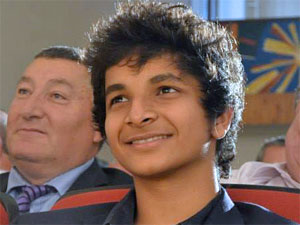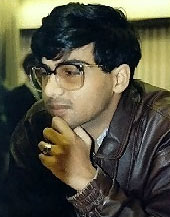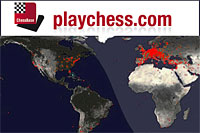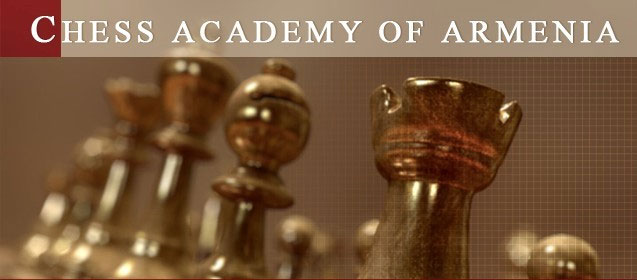
Déjà vu all over again
By IM Sagar Shah
It was December 1991. A young 22-year-old player from India by the name of Vishwanathan Anand was playing in northern Italy locking horns with the best in the world. It was the Reggio Emilia tournament. A 10 player round robin event with World Champion Garry Kasparov, Anatoly Karpov, Vassily Ivanchuk , Boris Gelfand and many strong players participating in it. And guess who won the tournament? The tiger from Madras: Vishy Anand.

|
All the other participants were from the European countries and seven of them from Russia. But the Indian won the tournament ahead of all of them and thus burst into the international chess scene as one of the top players in the world.
Anand was so happy at his victory that as soon as it became clear he sent a fax (at the time there was no Internet or mobile phones – the fax was emerging technology!) to his family and to Frederic Friedel in Germany. This historic document simply read:
I won the tournament!
I won the tournament!
I won the tournament!
|
|
Fast forward twelve and a half years and we are in July 2014. A category 16 event round robin event was held in Armenia. There were ten players and the average Elo of the tournament was 2629. So why did we mention about the Reggio Emilia tournament of 1991-92 and Vishy Anand? Well, have a look at this cross table of the 2014 Lake Sevan tournament:
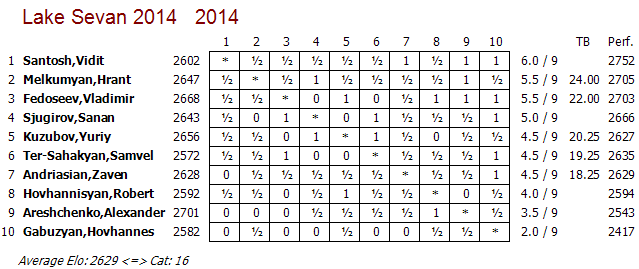
Do you notice the similarity? Nine players from the former Soviet Union countries like Armenia, Russia and Ukraine, and one player from India! And Vidit Santosh Gujrathi won the tournament, just like Vishy Anand.

Tournament winner Vidit Santosh Gujrathi of India
The similarities don’t just end there. Vidit was the seventh seed in this event and so was Vishy Anand. They both scored 6.0/9. And the most interesting of all: both Indian players beat the top seed, Kasparov in case of Anand and Areshchenko in case of Vidit, with the black pieces, using the French Defence! Talk about déjà vu all over again.
The 2014 edition of Lake Sevan round robin event was held from 27th July-4th August in Martuni Cultural Palace. It was quite a strong event. The top seed was world number 45 Alexander Areshchenko from Ukraine with a rating of 2701. But the most important thing about the participants was that everyone was young and ambitious. This guaranteed a lot of fighting chess and there were hardly any agreed draws.
After the tournament I was able to get in touch with Vidit and had quite an interesting Skype chat with him. Let us look at this beautiful tournament from the eyes of the winner!
Sagar Shah: How does it feel to win such a strong category 16 event?
Vidit Gujrathi: The feeling is wonderful. In fact this was my first robin event and I went there without any expectations. Thinking about final standings is hardly useful. The only thing I wanted to do was to play fighting chess. Hence, it feels even better to win the tournament.
Sagar: So Vidit, tell us about the conditions over there. You were the only non-European player. How did it feel?
Vidit: It was one of the most wonderfully organized events I have played in. I would first of all like to thank Armenian chess federation and its president Smbat Lputian for inviting me to this tournament.
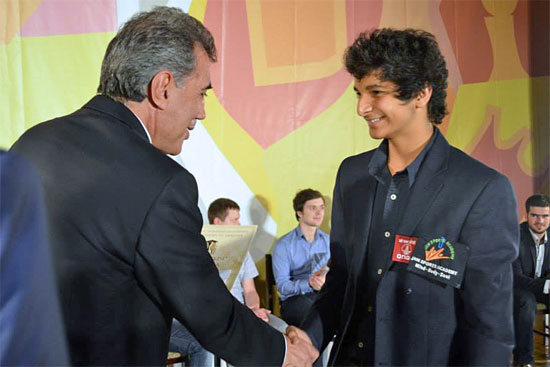
GM Smbat Lputian congratulates Vidit and hands him the winner’s purse of €4000
The playing hall was excellent. All the players were given single rooms and everything was wonderfully taken care of. Most importantly, the people were co-operative and friendly and hence rather than feeling different about being the only non-European player, I had great fun and made many new friends!
Sagar: Coming to the tournament, what was your schedule like?
Vidit: This time I had consciously decided to not to prepare too much. I would prepare for two hours before the game and around one hour after. The rest of the time all the players would meet and we would play games like ping pong and billiards! You could say that I spent more time on the ping pong table than at the chessboard before the game! This method worked out really wonderfully for me.
Sagar: Robert Hovhannisyan was your first round opponent. You pressed him in an endgame from move 24 to move 92 before agreeing to a draw. Were you seriously trying win this position?
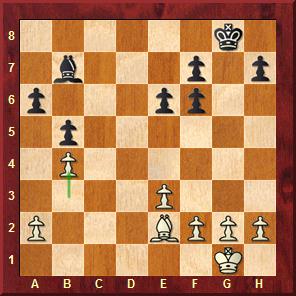
Vidit, who was White, played 25.b3-b4 in this position
Vidit: Well, I was just enjoying the position. I risked absolutely nothing and had no chance of losing and hence played on till the very end. Maybe if he went wrong I could capitalize on his mistake.
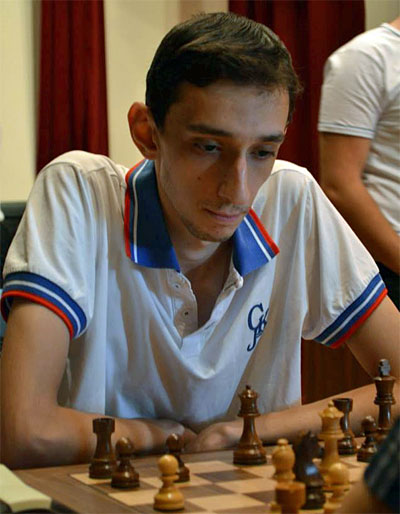
Robert Hovhannisyan (2592) finished eighth in the event, with a performance of 2590
Sagar: Round two and three against Kuzubov and Sjugirov were draws. How was your mind set against the top seed Areshchenko in the fourth round?
Vidit: My game with Sjugirov in round three was a real heartbreak. I was totally winning and missed so many chances. So I was really angry with myself after the third round. I just wanted to forget everything and start a new tournament. So I played a lot of ping pong that night and hardly prepared for my game with Areshchenko. And it worked: I won my game against the top seed!
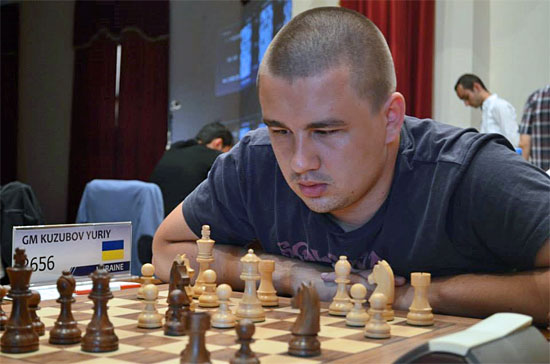
Fifth place: Yuri Kuzubov (2656) with a score of 4.5/9

Sanan Sjugirov (2645) had a wonderful start with 4.0/5.
But later he lost steam and finished fourth with a score of 5.0/9.
Sagar: And the French Defence against Areshchenko! You played that opening for the first time in your life.
Vidit: Yes I just wanted some fresh position. I was bored of the same old openings for that game. I decided French would be a good choice. I had some preparation and decided to give it a go! But mainly I was aiming for a fighting game.

Top seed Areschenko had a forgettable tournament:
he scored 3.5/9 finishing ninth and lost nearly 20 Elo points
Here’s the game against Areshchenko annotated by Vidit himself.

[Event "Lake Sevan 2014"] [Site "Martuni ARM"] [Date "2014.07.30"] [Round "4.1"] [White "Areshchenko, Alexander"] [Black "Vidit, Santosh Gujrathi"] [Result "0-1"] [ECO "C18"] [WhiteElo "2701"] [BlackElo "2602"] [Annotator "Gujrathi,Vidit"] [PlyCount "98"] [EventDate "2014.07.27"] {Despite having good chances in the previous games I was still without a win and had managed only 1.5/3.} 1. e4 e6 $5 {The French Defence. I decided to try something new as I considered that the unbalanced character of this opening would suit my mood perfectly.} 2. d4 d5 3. Nc3 Bb4 4. e5 c5 5. a3 Bxc3+ 6. bxc3 Ne7 7. Qg4 O-O {This move looks like a suicide,but it is indeed quite solid.} ( {More popular & crazier is} 7... Qc7 8. Qxg7 Rg8 9. Qxh7 cxd4 10. Ne2 Nbc6 11. f4 dxc3) 8. Bd3 Nbc6 9. Qh5 Ng6 10. Nf3 Qc7 11. Be3 c4 12. Bxg6 fxg6 13. Qg4 Bd7 {The main line is Qf7 but I think White is doing quite well there. Generally in this line White tries to attack on the kingside, whereas Black hopes to organise some counterplay on the queenside and along the f-file.} 14. h4 Rf5 15. Ng5 $5 {The direct h5 is the main move and has scored very well. With Ng5 White is now preparing h5, but it allows Black some time to regroup.} Qa5 16. Kd2 Raf8 17. f3 h6 18. h5 (18. Nh3 {is certainly better. Maybe Alexander just missed my next move.}) 18... Qd8 $1 {An important defensive resource.} ({It is interesting to see how the engines are misleading in such positions: they show 0.00 after} 18... gxh5 {but I think it is close to lost after that.}) 19. Nh3 $6 ({I was expecting to see the ending after} 19. hxg6 { Although the engines give advantage to black I think white can easily hold.} Rxg5 20. Bxg5 Qxg5+ 21. Qxg5 hxg5 22. Rh5 Ne7 23. Rxg5 Be8 24. Rh1 Nxg6) 19... gxh5 20. Qg3 h4 21. Qh2 Ne7 22. Nf4 Qe8 {Rg5 was another interesting alternative, with the idea to play Rxf4!? after Qh4. But I rejected it because I didn't see more than a repetition after Ne2-Rg6} (22... Rg5 $5) 23. Ne2 (23. Qxh4 Rxf4 24. Bxf4 Ng6) 23... Ng6 24. f4 {White's only plan is to organise some kind of play on the g-file.} Qf7 {Not the best. It was probably better to play R5f7, but I was quite tempted by the exchange sacrifice.} 25. Raf1 b5 26. Rf3 Kh7 $5 {Only engines can properly evaluate the crazy mess after Qe7.} ( 26... Qe7 27. g4 R5f7 28. Bf2 Qxa3 29. Bxh4 b4 30. g5 $132) 27. Rg1 Rg8 { Protecting g7 in advance, as the g-file is going to open sooner or later.} 28. g4 hxg3 29. Nxg3 Ne7 {Somewhere around here Alexander offered me a draw. But this was the type of position I was aiming for when I play Qf7. I thought that with black knight on f5 defending h6 and g7 Black has a free hand on queenside and White cannot do much.} 30. Kc1 Be8 $1 {Bishop would be best placed on the h7-b1 diagonal} 31. Kb2 a5 32. Bd2 Qf8 33. Nxf5 Nxf5 34. Be1 Bg6 35. Qd2 Qf7 36. Rh3 Kh8 {I wanted to improve my position to the maximum before going for the b4-break. Also I thought it is wise to complete the time control on 40 moves before changing the character of position,} 37. Bh4 Bh7 38. Ka2 Rb8 39. Rb1 Qh5 40. Qh2 Qe8 41. Qd2 b4 $1 {Finally !} 42. cxb4 Qa4 {During the game I considered Bf2 to be more tenacious} 43. b5 $6 (43. Bf2 $142 axb4 44. Rxb4 Rxb4 45. Qxb4 Qxc2+ 46. Qb2 Qd1 {Of course Black is still better, but White can set up a tough defence with Rc3 !}) 43... Nxh4 44. Rxh4 Bxc2 ({clearly bad is} 44... Qxc2+ $2 45. Qxc2 Bxc2 46. Rb2 Bb3+ 47. Rxb3 $1 cxb3+ 48. Kxb3 Rxb5+ 49. Ka4 $132) 45. Rb2 Bb3+ 46. Kb1 {White is threatening the scary f5, followed by Rh6. But fortunately Black has enough time for some tricks of his own !} Qxb5 $1 47. f5 $2 (47. Rh3 {controlling c3 was better, although even here Black can play} Kh7 {[%cal Gb8b6,Rb5a4,Ra4a3] and Rb6 to avoid all f5-Rh6 ideas, and then Qa4-Qa3. White is pretty much helpless.}) 47... c3 $1 48. Qxc3 Qf1+ 49. Qc1 Bc2+ {Although there were number of inaccuracies by both sides I felt quite optimistic after this win :)} (49... Bc2+ 50. Kxc2 Rc8+) 0-1
Sagar: After the win with Areshchenko you played another great game against Zaven Andrisian.
Vidit: Yes I managed to win that game convincingly. After the game he told me that he was confused with some move orders in the opening. He made a huge mistake there and after that it didn’t take much efforts from me to win the game.

[Event "Lake Sevan 2014"] [Site "Martuni ARM"] [Date "2014.07.31"] [Round "5.1"] [White "Vidit, S."] [Black "Andriasian, Z."] [Result "1-0"] [ECO "D18"] [WhiteElo "2602"] [BlackElo "2628"] [Annotator "Sagar Shah"] [PlyCount "61"] [EventDate "2014.07.27"] [EventRounds "9"] [EventCountry "ARM"] [EventCategory "16"] [Source "Mark Crowther"] [SourceDate "2014.08.04"] 1. d4 d5 2. c4 c6 3. Nf3 Nf6 4. Nc3 dxc4 5. a4 Bf5 6. e3 e6 7. Bxc4 Nbd7 8. O-O Bb4 9. Nh4 Bg4 10. f3 Bh5 11. g4 Nd5 12. Ng2 Bg6 13. Na2 Bd6 14. e4 N5b6 15. Bb3 Qc7 $6 (15... h5 $132 {would have lead to an interesting position.}) 16. a5 $1 Nc8 (16... Bxh2+ 17. Kh1 Nc8 18. f4 {[%csl Rh2] The bishop on h2 is awkwardly placed.}) 17. e5 $1 Be7 18. f4 $16 {White has a huge advantage. Black is passive and White won the game easily.} Be4 19. Nc3 Bxg2 20. Kxg2 Bb4 21. f5 Nf8 22. Ne4 Bxa5 23. fxe6 fxe6 24. Nd6+ Nxd6 25. exd6 Qb6 26. Bg5 Rd8 27. Qf3 Rd7 28. d5 Qb5 29. Be7 Rxe7 30. dxe7 Kxe7 31. dxe6 1-0
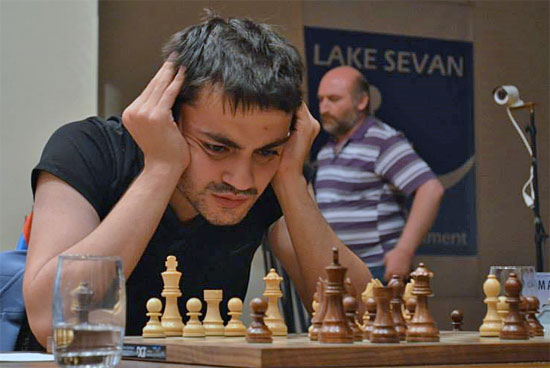
Zaven Andriasian (2628) finished seventh with 4.5/9 and a performance equivalent to his rating
Sagar: You were 3.5/5. Were you starting to think about winning the tournament?
Vidit: No, not at all. I did not think about the standings until the last round. From my previous experiences I have known how harmful it is to think about it! [laughs]
Sagar: A Petroff Defence against Fedoseev in the sixth round. Once again I think first time in your life! Why the Petroff?
Vidit: I think that day I was in a creative mood. Well, you cannot really say creative because Petroff is hardly an opening which allows you to be creative, but I thought it will give me a fresh position which will be interesting to play. So just like how I decided French against Areshchenko, I went for the Petroff against Fedoseev and drew quite easily.
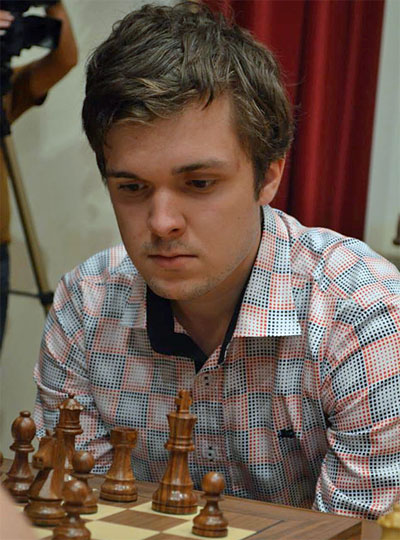
Vladimir Fedoseev (2668) had a good tournament scoring 5.5/9 and finishing third
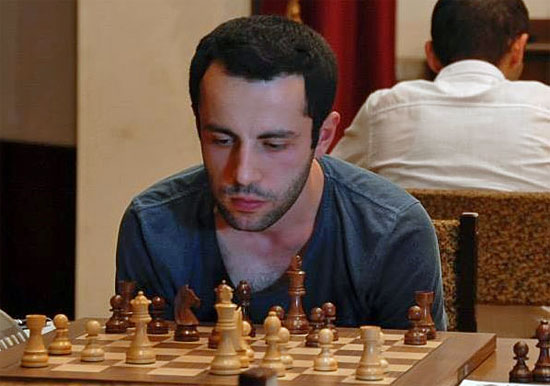
The runner up Hrant Melkumyan with 5.5/9 and a performance of 2707
Sagar: After draws with Fedoseev and Melkumyan in round six and seven you were playing against Hovhannes Gabuzyan. Did you go with a must-win approach?
Vidit: I was in a fighting mood in that game and hence went for a slightly tricky line in the opening with the move 8.Bf4!? in the Averbakh System of the King’s Indian Defense. He managed to equalise but the game was still quite tricky. After mutual inaccuracies we reached an equal endgame. There he made a critical error with the move 32…b5. I was a pawn up after that and played on happily in that position to convert it into a full point.

[Event "Lake Sevan 2014"] [Site "Martuni"] [Date "2014.08.03"] [Round "8.5"] [White "Santosh, Vidit"] [Black "Gabuzyan, Hovhannes"] [Result "1-0"] [ECO "E70"] [WhiteElo "2602"] [BlackElo "2582"] [PlyCount "121"] [EventDate "2014.07.27"] [EventRounds "9"] [EventCountry "ARM"] 1. d4 Nf6 2. c4 g6 3. Nc3 Bg7 4. e4 O-O 5. Be2 c5 6. d5 d6 7. Bg5 h6 8. Bf4 a6 9. a4 Re8 10. Qd2 g5 11. Be3 e6 12. dxe6 Rxe6 13. f3 Nc6 14. Nh3 Nd4 15. Rd1 Nh5 16. g4 Re8 17. O-O Be5 18. Nxg5 hxg5 19. gxh5 Kh8 20. Kh1 Rg8 21. f4 Nb3 22. Qe1 gxf4 23. Bxf4 Bxf4 24. Rxf4 Qg5 25. Qf2 Be6 26. Nd5 Nd4 27. Bd3 Rg7 28. Rg1 Qxg1+ 29. Qxg1 Rxg1+ 30. Kxg1 Kg7 31. Kf2 Rh8 32. Nf6 b5 33. cxb5 axb5 34. Bxb5 Nxb5 35. axb5 Rb8 36. Kg3 Kh6 37. Rf2 Rxb5 38. Kf4 c4 39. Rd2 Rb8 40. Rg2 Ra8 41. Ke3 Ra1 42. Rd2 Ra6 43. Kd4 Kg5 44. Nd5 Kxh5 45. Kxc4 Kg4 46. b4 Kf3 47. Kd4 Ra1 48. Rd3+ Kg4 49. Rg3+ Kh4 50. Nc3 Ra3 51. Nb5 Ra4 52. Kc3 d5 53. Nd4 dxe4 54. Nxe6 fxe6 55. b5 Ra1 56. Re3 Rc1+ 57. Kb2 Rc5 58. b6 Rc8 59. Rxe4+ Kg5 60. Rxe6 Kf5 61. b7 1-0
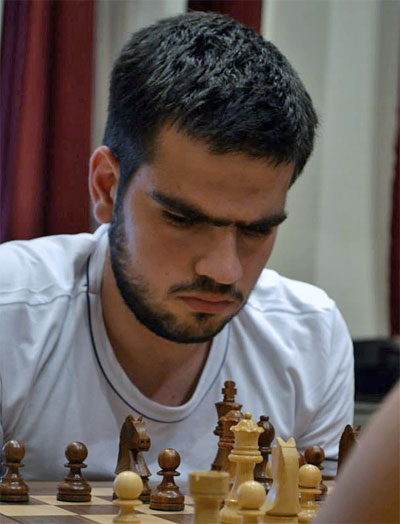
Hovhannes Gabuzyan (2582) finished last scoring just 2.0/9 and losing 18 rating points
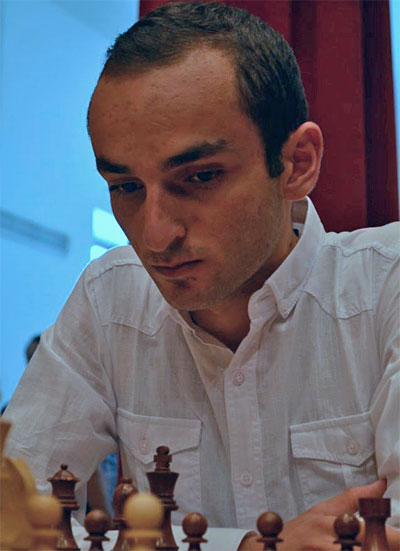
Sixth place: Samvel Ter-Sahakyan with 4.5/9
Sagar: In the last round you faced Ter-Sahakyan Samvel and you had a half point lead. You played the Petroff again. Weren’t you afraid of some preparation by your opponent, especially after you had played the opening a few games ago?
Vidit: The Petroff cannot be refuted! And it is such a solid opening that in this situation it looked like the right choice. I was initially also thinking of going for a Caro-Kann. But then I noticed the game Samvel-Hovhannisyan from the same tournament. That was really crazy, with White making a queen and the black king on e3.

[Event "Lake Sevan 2014"] [Site "Martuni"] [Date "2014.07.29"] [Round "3.5"] [White "Ter-Sahakyan, Samvel"] [Black "Hovhannisyan, Robert"] [Result "1/2-1/2"] [ECO "B12"] [WhiteElo "2572"] [BlackElo "2592"] [PlyCount "122"] [EventDate "2014.07.27"] [EventRounds "9"] [EventCountry "ARM"] 1. e4 c6 2. d4 d5 3. e5 Bf5 4. h4 Qb6 5. a4 h6 6. a5 Qc7 7. a6 Nxa6 8. Bxa6 bxa6 9. Ne2 e6 10. O-O Be7 11. Ng3 Bh7 12. Qg4 Bf8 13. Nh5 g6 14. Ng3 g5 15. c3 gxh4 16. Nh5 Bg6 17. Nd2 Qb7 18. Nf3 h3 19. Qxh3 Qb5 20. Re1 O-O-O 21. b4 Bf5 22. Qg3 Ne7 23. Nf6 Ng6 24. Bd2 Be7 25. Ra5 Qd3 26. Rea1 Kb7 27. Be1 Ra8 28. Rxa6 h5 29. Qg5 h4 30. Qc1 Qxa6 31. Rxa6 Kxa6 32. Ng5 h3 33. g4 Bxf6 34. exf6 h2+ 35. Kh1 Bxg4 36. f3 Bh3 37. Kxh2 Bf5+ 38. Kg2 Rhg8 39. Bg3 Nh8 40. Qa3+ Kb5 41. Qa5+ Kc4 42. f4 Kb3 43. Kf2 Rab8 44. Qa1 a5 45. bxa5 Kc2 46. a6 Rb1 47. Qa4+ Kd3 48. a7 Rb2+ 49. Kf1 Ke3 50. a8=Q {[#]} Rb1+ 51. Be1 Rxa8 52. Qxa8 Ng6 53. Qa2 Bd3+ 54. Kg2 Nxf4+ 55. Kg3 Ne2+ 56. Kh2 Rxe1 57. Qa7 Nf4 58. Qxf7 Re2+ 59. Kh1 Re1+ 60. Kh2 Re2+ 61. Kh1 Re1+ 1/2-1/2
This position literally convinced me that Caro Kann was not such a good idea! So I played the Petroff. That too was a complicated struggle but I managed to draw and thus win the tournament.
Sagar: Wonderful! And I think the closing ceremony was also quite unique.
Vidit: Yes. I witnessed the Armenian culture, and they had also had Russian, Ukrainian and Indian performers at the closing ceremony. It was really a nice event.

Interesting performances at the closing ceremony

The two Ukrainians Yuriy Kuzubov and Alexander Areshchenko having a good time!

Vladimir Fedoseev having a good time – in his own way
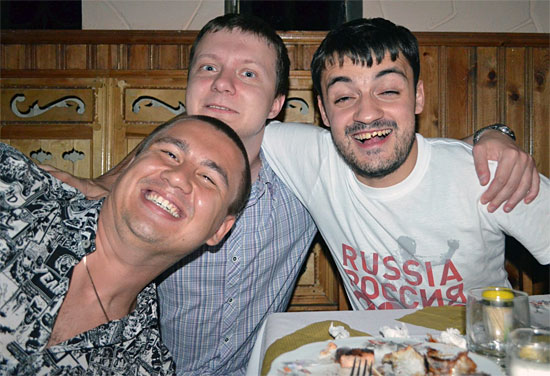
The picture, with Kuzubov, Areshchenko and Zaven Andriasian, sums it all. There were
brutal fights on the chess board but off the board they were all great friends!
Vidit: Lastly I would like to mention that when I was preparing for this tournament, I tried to inspire myself by looking at games of Vishwanathan Anand from Reggio Emilia tournament 1991-92. He played against all the nine players from European nations, mainly Russia, and won the tournament. The tournament he won was way stronger than this one, but it feels nice to have emulated his effort in some way!
Sagar: Thanks Vidit for this interview. I hope that you will emulate Vishwanathan Anand’s many more achievements in future.
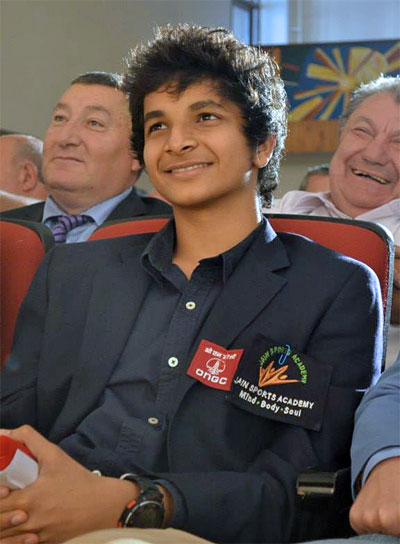
Vidit Gujrathi is one of the most talented youngsters from India. Born in 1994, Vidit already has a number of great achievements to his credit:
- In 2008 Vidit became champion of the World U14 Junior Chess Championship held in Vietnam.
- In 2009 he took silver medal in the World U16 Junior Chess Championship held in Turkey.
- Vidit became four-time joint champion of the Asian Youth Chess Championship in different age groups /U-12 Delhi 2005, U-12 Iran 2006, Under-14 Iran 2008, U-20 Chennai 2010/.
- Vidit is four-time National Youth Champion /U-11 Nagpur 2005, U-13 Bhiwani 2006, U-13 Delhi 2007, U-15 Mumbai 2009/.
- In 2013 he became bronze medal winner in the World Junior Chess Championship in Turkey.
He will be spearheading the Indian challenge in the World Junior Championships that will take place in Pune, India in October 2014. You can know more about him from this interview which was taken after he won the bronze medal in the World Junior Championships 2013.
Pictures taken from the Facebook page of Chess Academy of Armenia
